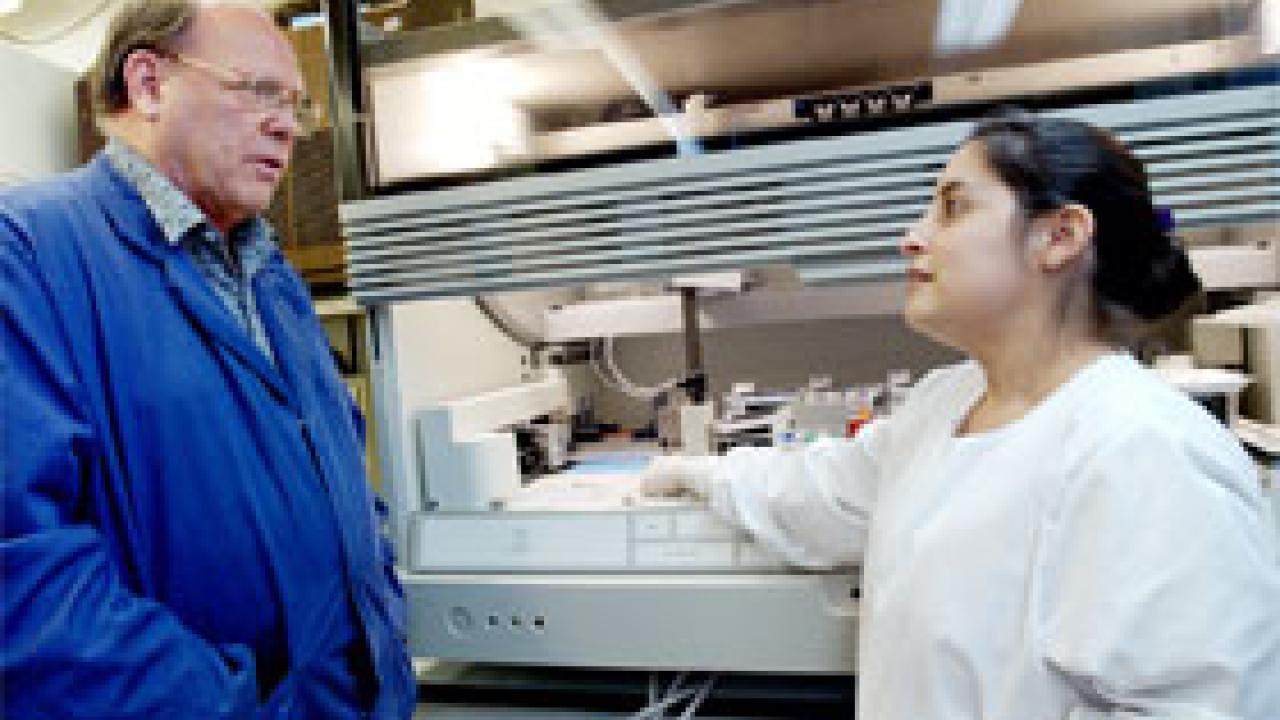Any day now West Nile virus, a potentially deadly pathogen that claimed the lives of 264 people nationwide last year, is expected to expand its range into the northern reaches of California.
Recent weeks have seen a tremendous surge in the number of dead birds from Southern California -- mostly crows, jays and other members of the corvid family --testing positive for the presence of the virus. Central to the state's efforts to track movement of the disease is a little-known UC Davis program called the Center for Vectorborne Diseases. So far this year the center has tested more than 1,000 dead birds and 3,000 "pools" of mosquitoes. The center's reputation for accurate, quick analysis is one of the main reasons it has been given such a critical role in tracking the virus.
"We're isolating West Nile virus from Southern California every week," said John Edman, director of the center and professor of medical entomology. "Seventy to 80 percent of the dead birds being examined are testing positive. At that rate, it's very likely it will show up this summer in the center's tests of birds and mosquitoes collected in Northern California."
The center's chief job is to confirm or deny the presence of West Nile virus in tissue samples from wild birds and from mosquitoes.
Dead birds are first necropsied at the California Animal Health and Food Safety Laboratory in the School of Veterinary Medicine. Tissue samples are then sent to the center's Level 3 biocontainment facility for further testing. Mosquitoes are collected by biologists working for local mosquito abatement districts, pooled by species, frozen and shipped to the center on dry ice. Blood from horses, which are extremely vulnerable to West Nile virus, is also tested at the center. (Serum samples from humans suspected of having the virus and from flocks of "sentinel" chickens are tested at a state laboratory in Richmond.)
As of June 25, the Center for Vectorborne Diseases had confirmed West Nile virus in 492 dead birds, 76 mosquito pools and 31 sentinel chickens. Ten human cases -- none of them fatal -- have been reported this year in Southern California. The virus, first documented in the United States just five years ago in New York, now has been detected in all low-er 48 states except Oregon and Washington.
The center was established at UC Davis in 1996 as a joint venture between the School of Veterinary Medicine and the College of Agricultural and Environmental Sciences. It now includes the Medical School as well. Core funding was provided through the transfer of the Arbovirus Research Unit from the UC Berkeley School of Public Health to UC Davis.
In addition to the diseases of humans, do-mesticated animals and wildlife that are transmitted by mosquitoes and biting flies, the center studies disease pathogens carried by vectors such as ticks, fleas, crustaceans, mollusks, even rodents. "We define vectorborne very broadly," Edman says. "We don't cover leeches, but they don't transmit anything."
About 30 faculty members are affiliated with the center. Some of them have been instrumental in developing a fuller understanding of West Nile virus. For instance, campus entomologists specializing in how mosquitoes transmit disease identified Culex tarsalis, one of the more common species in California, as particularly efficient at transmitting the disease to people, domesticated animals and wildlife. Other campus scientists are focusing on the ecology of the disease in wildlife populations, mosquito control practices and, at the Center for Equine Health, the effectiveness of vaccines for horses.
"Since Dr. Edman's arrival in the Center for Vectorborne Disease, the center has been in a growth mode," said Bennie Osburn, dean of the School of Veterinary Medicine. "The program has had significant growth in funding from the National Institutes of Health, we have brought on new faculty, and we have geared up to address the West Nile virus invasion of the state. Dr. Edman has led us to new heights."
Safety is a paramount concern
The inside of the "hot lab" at the center's biocontainment facility employs a number of safety precautions, such as filtering all the air and autoclaving all laboratory equipment. Double screen doors lead to an insectary where mosquitoes can be reared. And nothing substitutes for the confidence born of training and experience. "I trust my aseptic techniques to protect me," says Nicole Kahl, one of the primary laboratory technicians involved in surveillance testing.
Edman and the center's staff anticipate a busy summer. He has already received many media inquiries.
"Reporters want you to pull out your crystal ball and predict where it will spread, whether it will persist and so on. These are questions we can't really answer yet," he said. "But it would surprise me if it didn't show up in the Central Valley this year."
